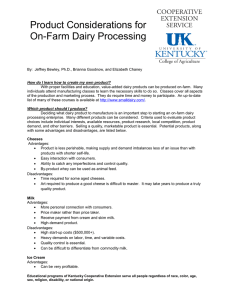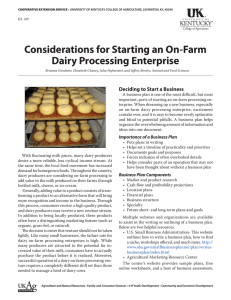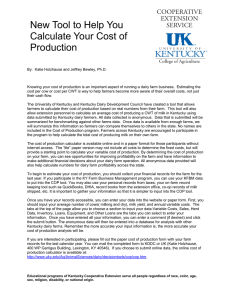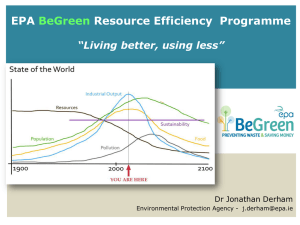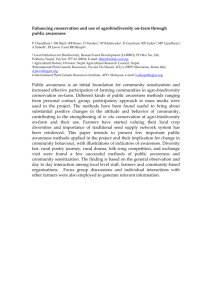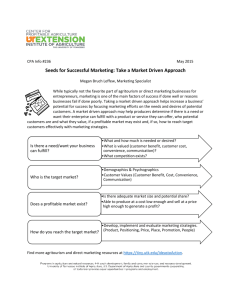Marketing Considerations for On-Farm Dairy Processing
advertisement
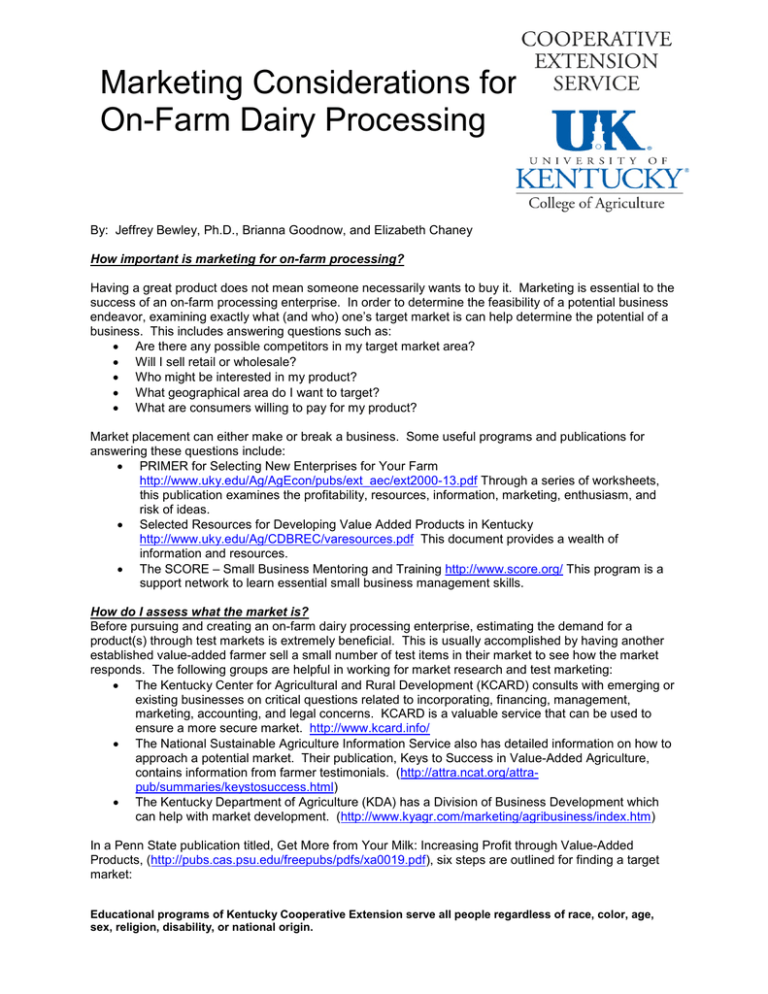
Marketing Considerations for On-Farm Dairy Processing By: Jeffrey Bewley, Ph.D., Brianna Goodnow, and Elizabeth Chaney How important is marketing for on-farm processing? Having a great product does not mean someone necessarily wants to buy it. Marketing is essential to the success of an on-farm processing enterprise. In order to determine the feasibility of a potential business endeavor, examining exactly what (and who) one’s target market is can help determine the potential of a business. This includes answering questions such as: • Are there any possible competitors in my target market area? • Will I sell retail or wholesale? • Who might be interested in my product? • What geographical area do I want to target? • What are consumers willing to pay for my product? Market placement can either make or break a business. Some useful programs and publications for answering these questions include: • PRIMER for Selecting New Enterprises for Your Farm http://www.uky.edu/Ag/AgEcon/pubs/ext_aec/ext2000-13.pdf Through a series of worksheets, this publication examines the profitability, resources, information, marketing, enthusiasm, and risk of ideas. • Selected Resources for Developing Value Added Products in Kentucky http://www.uky.edu/Ag/CDBREC/varesources.pdf This document provides a wealth of information and resources. • The SCORE – Small Business Mentoring and Training http://www.score.org/ This program is a support network to learn essential small business management skills. How do I assess what the market is? Before pursuing and creating an on-farm dairy processing enterprise, estimating the demand for a product(s) through test markets is extremely beneficial. This is usually accomplished by having another established value-added farmer sell a small number of test items in their market to see how the market responds. The following groups are helpful in working for market research and test marketing: • The Kentucky Center for Agricultural and Rural Development (KCARD) consults with emerging or existing businesses on critical questions related to incorporating, financing, management, marketing, accounting, and legal concerns. KCARD is a valuable service that can be used to ensure a more secure market. http://www.kcard.info/ • The National Sustainable Agriculture Information Service also has detailed information on how to approach a potential market. Their publication, Keys to Success in Value-Added Agriculture, contains information from farmer testimonials. (http://attra.ncat.org/attrapub/summaries/keystosuccess.html) • The Kentucky Department of Agriculture (KDA) has a Division of Business Development which can help with market development. (http://www.kyagr.com/marketing/agribusiness/index.htm) In a Penn State publication titled, Get More from Your Milk: Increasing Profit through Value-Added Products, (http://pubs.cas.psu.edu/freepubs/pdfs/xa0019.pdf), six steps are outlined for finding a target market: Educational programs of Kentucky Cooperative Extension serve all people regardless of race, color, age, sex, religion, disability, or national origin. Marketing Considerations for On-Farm Dairy Processing 1. Find out what market you are interested in (retail, groceries, restaurants, specialty food stores, a farm store, community supported agriculture, or the farmers market). 2. Look at the population data of the market area you have in mind, looking at this larger picture can be helpful. U.S. Census data or the local chamber of commerce has this information. 3. Take this population number and estimate what percentage might be interested in your product. Do this by thinking about location boundaries (county or zip code), demographics, and price sensitivity (take a look at income data as a benchmark). 4. Talk with managers of similar, potential markets to see if their customer patterns match. 5. Create an analysis for each target market to estimate total sales in a given time period and with different sales scenarios – this can be easily done in a spreadsheet. 6. Total the sales estimates and update your spreadsheet documents accordingly as your involvement with these markets change through time. What is the demand for value-added dairy products? Consumer interest is usually the first signal that on-farm processing might be a path to pursue. Perception of a superior product drives its value. The unique story behind a product drives its perceived benefits. Since value-added products have a higher value to consumers, they often also have a higher retail price. Attributes used to differentiate between products include organic, local, natural, grass-fed, pasteurization technique, fair-trade, kosher, allergen-free, and humane treatment. More information on becoming a U.S. Department of Agriculture certified organic dairy can be found through the Kentucky Department of Agriculture (http://www.kyagr.com/marketing/plantmktg/organic/). Although the USDA does not have a certification system for defining a product as natural, those that are free of hormones and antibiotics, are considered natural. Certification systems for local products such as KDA’s Kentucky Proud (http://www.kyproud.com/) also exist. Consumer demand for higher quality food, specialty foods, and health food products are market drivers. Trends show that people continue to buy more specialty products relative to mainstream products in every market category. Fluid milk trends show the market for organic milk is growing, although organic milk is a very small percentage of total milk sales. Other characteristics are also attractive to consumers such as rBST (recombinant bovine somatotropin) free. Specialty cheeses have seen a significant market boom in the last decade due to increased publicity for cheeses through restaurants that add value to individual menu items made with a specialty cheese. The media also has increased interest in specialty cheeses through programs focused on travel, food, and cooking. Ice cream has a wide array of target markets and characteristics because two large consumer interests are represented: healthy desserts and indulgence desserts. Yogurt is an important market with a reputation as a healthy snack that aids digestion. Convenience, through drinkable and frozen yogurts, has also increased demand for this product. Certain consumers eat yogurt more than others, particularly women, children, Hispanics, and Asians. How will I sell and distribute my product? How a product will reach consumers is important to consider before beginning to manufacture it. The target market will dictate distribution channels. Many market opportunities are available for value-added dairy products. However, getting into these markets is not as simple as it may seem. Some options include: Farmers Markets Many farmers markets exist all around the country. A directory of Kentucky farmers markets is available at the Kentucky Department of Agriculture website http://www.kyagr.com/marketing/farmmarket/2012FarmersMarketDirectory.htm. Entry and space rental fees vary among markets. Educational programs of Kentucky Cooperative Extension serve all people regardless of race, color, age, sex, religion, disability, or national origin. Marketing Considerations for On-Farm Dairy Processing Retail Local, value-added products have a small, but strong niche market in many specialty grocery stores and some regional and national grocery chains. Larger markets require larger quantities of a product, so cooperative efforts among a few dairies are sometimes beneficial in pursuing this kind of market. On-Farm Sales Setting up a farm store or stand and offering on-farm sales is another option. On-farm sales are often coupled with agritourism, and farms often offer lunch options, farm tours, and sell a small variety of products in the farm store. Populations, family income, and road traffic near the potential distribution point are important factors to consider in the decision to start an on-farm store. The Kentucky Department of Agriculture has a Division of Agritourism that has more information on establishing a farm store or stand. It is available online at http://www.kyagr.com/marketing/agritourism/index.htm. Community Supported Agriculture (CSA) In a CSA program, individuals contract with a farmer to receive a weekly or bi-weekly basket of products from the farmer for a fixed price over the course of the growing season. Many farmers have expanded their CSAs to include value-added products like dairy, eggs, and meat in order to add more value to the baskets and to carry the market through the winter. As a result, an existing CSA program may be a viable market option for some. The location of existing CSAs is available through http://www.localharvest.org. Institutional Buying This involves direct contracts to sell products to an institution, such as a school, university, hospital, nursing home, business, or restaurants. This type of market may be seen as a more secure situation, because of contracts. How can agritourism supplement my on-farm processing enterprise? According to the Kentucky Farms Are Fun website (http://www.kentuckyfarmsarefun.com/), agritourism is defined as, "The act of visiting a working farm or any agricultural, horticultural, or agribusiness operations for the purpose of enjoyment, education, or active involvement in the activities of the farm or operation." Many farms only do agritourism, while others combine agritourism and an on-farm processing venture. Agritourism is an excellent way to educate the public on the importance of agriculture and involves considerable public interaction, people skills, and relationship building skills. Some events may involve school tours, individual tours, or hosting community events. Establishing this relationship with a community helps to increase rural economic development dollars and develop community support for agriculture. Agritourism can be a very profitable, fulfilling addition to a farm when properly managed and planned. Farms should be presentable to the public. When bringing the public onto a farm, the correct insurance and liability coverage is important. Interacting with the community, the insurance company, and even those who have agritourism businesses in different areas is key and very helpful in planning one’s operation. How should I interact with customers and suppliers? When owning and operating a business, working with the public is inevitable. Business owners must interact with customers, employees, suppliers, or investors and effectively communicate with each one. For some farmers, this can be a favorite part of owning a business, and for others it can be the worst. Most farmers do not have to work with people on a daily basis, and this can be a huge adjustment for them. Representing the product is very important and critical when working with customers. When selling a product, entrepreneurs must know the type of consumer the product attracts. Be prepared to answer questions about the product’s origins, production process, attributes, and strengths and weaknesses compared to competitors. Being able to establish that relationship with the customer and make them feel that they need the product is something very important to making the sale. When deciding on marketing strategies, capitalize on a product’s attributes and stress those when marketing the product. Educational programs of Kentucky Cooperative Extension serve all people regardless of race, color, age, sex, religion, disability, or national origin. Marketing Considerations for On-Farm Dairy Processing Dealing with objections is also another huge part of working with the public. Unhappy customers can come along for many different reasons. Dealing with and understanding how to communicate with these customers is just a part of business. This is particularly true when the possibility for foodborne illnesses exist. On-farm processing enterprises must have a contingency plan for dealing with recalls or illness outbreaks. Remember that the only bad objection is the one that is not heard. Objections should be considered as constructive criticism. Make sure to understand the objection and try to change that person’s perspective of the product. Objections cannot only be from unhappy customers, they can be from customers who feel as if they may not need the product, may not have the money, or simply may not want it. In each of these situations, a seller should work toward persuading the customer but know when to quit and always avoid arguments. When owning and operating a business, an owner is going to work very closely with their suppliers. These suppliers are responsible for the inputs that go into making a product. Lines of communication with suppliers should always remain open. Suppliers should be treated well for everything they contribute to the business. Working with the public can be as simple as knowing how to communicate effectively. One should always be confident when talking to a customer, supplier, or employee. Business owners should value everyone who plays a role in the production and selling of a product. Having the ability to work with people is a very important aspect no matter what business one is in. Educational programs of Kentucky Cooperative Extension serve all people regardless of race, color, age, sex, religion, disability, or national origin.
